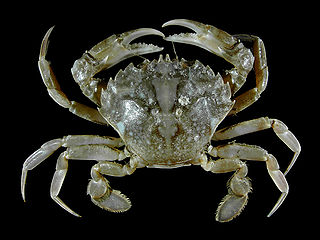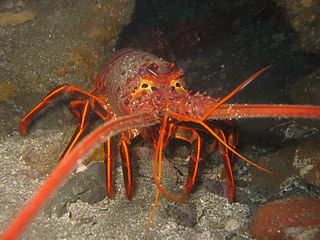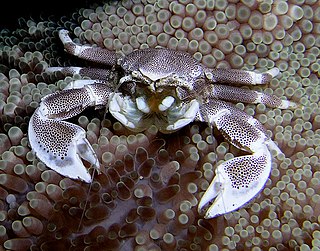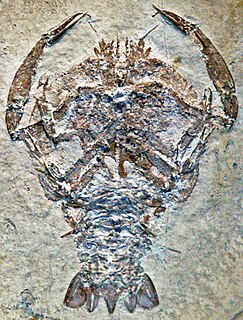
The Caridea, commonly known as caridean shrimp or true shrimp, are an infraorder of shrimp within the order Decapoda. This infraorder contains all species of true shrimp. They are found widely around the world in both fresh and salt water. Many other animals with similar names – such as the mud shrimp of Axiidea and the boxer shrimp of Stenopodidea – are not true shrimp, but many have evolved features similar to true shrimp.

Dendrobranchiata is a suborder of decapods, commonly known as prawns. There are 540 extant species in seven families, and a fossil record extending back to the Devonian. They differ from related animals, such as Caridea and Stenopodidea, by the branching form of the gills and by the fact that they do not brood their eggs, but release them directly into the water. They may reach a length of over 330 millimetres (13 in) and a mass of 450 grams (1.0 lb), and are widely fished and farmed for human consumption.

Crabs are decapod crustaceans of the infraorder Brachyura, which typically have a very short projecting "tail" (abdomen), usually hidden entirely under the thorax. They live in all the world's oceans, in fresh water, and on land, are generally covered with a thick exoskeleton, and have a single pair of pincers. They first appeared during the Jurassic Period.

Spiny lobsters, also known as langustas, langouste, or rock lobsters, are a family (Palinuridae) of about 60 species of achelate crustaceans, in the Decapoda Reptantia. Spiny lobsters are also, especially in Australia, New Zealand, Ireland, South Africa, and The Bahamas, called crayfish, sea crayfish, or crawfish, terms which elsewhere are reserved for freshwater crayfish.

The Decapoda or decapods are an order of crustaceans within the class Malacostraca, including many familiar groups, such as crabs, lobsters, crayfish, shrimp and prawns. Most decapods are scavengers. The order is estimated to contain nearly 15,000 species in around 2,700 genera, with around 3,300 fossil species. Nearly half of these species are crabs, with the shrimp and Anomura including hermit crabs, porcelain crabs, squat lobsters making up the bulk of the remainder. The earliest fossil decapod is the Devonian Palaeopalaemon.

The Achelata is an infra-order of the decapod crustaceans, holding the spiny lobsters, slipper lobsters and their fossil relatives.

Slipper lobsters are a family (Scyllaridae) of about 90 species of achelate crustaceans, in the Decapoda clade Reptantia, found in all warm oceans and seas. They are not true lobsters, but are more closely related to spiny lobsters and furry lobsters. Slipper lobsters are instantly recognisable by their enlarged antennae, which project forward from the head as wide plates. All the species of slipper lobsters are edible, and some, such as the Moreton Bay bug and the Balmain bug are of commercial importance.

Astacidea is an infraorder of decapod crustaceans including lobsters, crayfish, and their close relatives.

The Glypheoidea, is a group of lobster-like decapod crustaceans which forms an important part of fossil faunas, such as the Solnhofen limestone. These fossils included taxa such as Glyphea, and Mecochirus, mostly with elongated chelipeds. This group of decapods is a good example of a living fossil, or a lazarus taxon, since until their discovery in the 1970s, the group was considered to have become extinct in the Eocene. The superfamily Glypheoidea comprises five families. The two extant species, Neoglyphea inopinata and Laurentaeglyphea neocaledonica, are both in the Glypheidae.

Ibacus peronii, the Balmain bug or butterfly fan lobster, is a species of slipper lobster. It lives in shallow waters around Australia and is the subject of small-scale fishery. It is a flattened, reddish brown animal, up to 23 cm (9 in) long and 14 cm (6 in) wide, with flattened antennae and no claws.

Acanthacaris is a genus of deep-water lobsters. It contains two species, A. caeca and A. tenuimana, and is the only genus in the subfamily Neophoberinae.

Acanthochirana is an extinct genus of prawn that existed during the upper Jurassic period. It was named by E. Strand in 1928, and its type species is Acanthochirana cordata. They are distinguished from the related genus Aeger by the presence of teeth on the rostrum, which are absent in Aeger.

Parribacus japonicus, the Japanese mitten lobster, is a species of slipper lobster. Though the common name for this lobster is the Japanese mitten lobster, it is locally called zōri-ebi (ゾウリエビ) – zōri denoting the Japanese sandal it resembles, and ebi meaning shrimp or lobster.

Crustaceans may pass through a number of larval and immature stages between hatching from their eggs and reaching their adult form. Each of the stages is separated by a moult, in which the hard exoskeleton is shed to allow the animal to grow. The larvae of crustaceans often bear little resemblance to the adult, and there are still cases where it is not known what larvae will grow into what adults. This is especially true of crustaceans which live as benthic adults, more-so than where the larvae are planktonic, and thereby easily caught.

The Galatheoidea are a superfamily of decapod crustaceans comprising the porcelain crabs and some squat lobsters. Squat lobsters within the three families of the superfamily Chirostyloidea are not closely related to the squat lobsters within the Galatheoidea. The fossil record of the superfamily extends back to the Middle Jurassic genus Palaeomunidopsis.

Aurorazhdarcho is an extinct genus of ctenochasmatoid pterosaur known from the Late Jurassic period of what is now Bavaria, southern Germany.

Cancrinos is a genus of fossil crustacean closely allied with the slipper lobsters. One species is known, C. claviger from the Jurassic of southern Germany.
Tricarina is a genus of crustaceans of uncertain phylogenetic placement, known from a single incomplete fossil specimen from the Cretaceous of western Iran. It has a flattened body with three longitudinal ridges, which give it its name.

Cycleryon is an extinct genus of decapod crustaceans. The type species is Cycleryon propinquus.
Paracancrinos is a prehistoric genus of crustacean that lived during the Upper Cretaceous in what is now Lebanon. It contains a single species, P. libanensis, which was originally described as a species of Cancrinos in 2006, but was moved to its own genus in 2016.



















